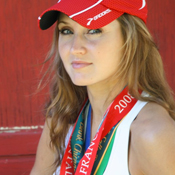Hurt Work
 I get it. I do. Throughout marathon training, you have to challenge your body’s different systems through a variety of workouts. Tempo runs to build lactate threshold. Long runs for aerobic fitness. Speedwork to stretch VO2 Max. Then, on race day, God willing and the creek don’t rise, all those physiological puzzle pieces come together to propel you across the finish line.
I get it. I do. Throughout marathon training, you have to challenge your body’s different systems through a variety of workouts. Tempo runs to build lactate threshold. Long runs for aerobic fitness. Speedwork to stretch VO2 Max. Then, on race day, God willing and the creek don’t rise, all those physiological puzzle pieces come together to propel you across the finish line.
Why, oh, why, then, do I always neglect one of the most critical aspects of training? Why am I so loathe to embrace hurt work?
Two Saturdays ago, I ran the Run for the Helmet 7K in Cottleville. It was my first race since GO! St. Louis Marathon training began in January. I’ve been up to my hip flexors in high mileage, but aside from a few tempo runs, nothing has been quick. My schedule called for a tune-up race, and the timing was perfect. I had been running volume for so long, my legs needed a refresher course on turnover speed.
But what I failed to recall from previous training cycles is that a tune-up race is more than just a reminder for your legs. It’s a reminder for your head as well. Namely, it’s a reminder that racing hurts.
Racing is hurt work.
Sure, I’ve had hard long runs with pace work mixed in. And, sure, I’ve struggled through tempo miles at Forest Park. But pain is a multi-faceted beast with a whole catalog of personalities and manifestations. Marathon pain is different than half marathon pain, and half marathon pain is different than 5K pain, and 5K pain is different than 800-meter pain, which I once heard described as the single worst experience in track and field.
Pain in running is like Dante’s Inferno. There are nine circles of suffering (at least), and each one has its own demons to overcome. I’m fairly comfortable navigating the outer layers, assuming they represent longer, slower runs. But the further inward I journey, to the shorter, faster distances, the more I begin to falter. The pain of the inner circles is more intense, more concentrated. The inner circles are where you find the pain of racing.
As I waited at the start line of the Run for the Helmet, vivid recollections of racing pain—the panicky, all-consuming sensation of unbearable discomfort—zinged my psyche. I knew it would come. It always does. What I didn’t know was how I would handle it.
Not especially experienced in racing 7Ks, primarily because I’ve never actually raced a 7K, I opted for a conservative approach in the first mile and then, well, I'd go from there. If I felt good, I’d pick up the pace. If not, I’d just try to maintain a steady rhythm.
Shockingly, I felt strong. And I even managed to keep my first mile conservative. Still, by mile three, the sharp and distinct pain of a 5K hit. I hadn’t felt 5K pain in almost eight months, but I recognized it immediately.
And my first reaction was to hit the breaks.
You’re going too fast! I thought. You can’t keep this up! Better slow down!
My brain instinctively switched to survival mode, and the mind-body negotiations began.
Unfortunately, I was out of practice when it came to physiological politicking. Because it had been so long since I had raced a 5K, I wasn’t confident in my ability to push beyond my pain threshold. Heck, I wasn’t confident what my pain threshold even was.
So I compromised. I told myself to hold pace. No slowing down. No speeding up.
In the end, I was thrilled with how the race played out. In the middle of marathon training and a high mileage week? Heck, yeah. I’ll take it. The Run for the Helmet was more than just a race day spark, it was a much-needed confidence boost.
Still, the next day, I couldn’t help but wish I could run the race again, the next week. I had to be re-introduced to 5K pain, and as a result, I had to re-learn how to deal with it.
“If I could do it again,” I told Jackie (who, by the way, had won the coveted helmet) as we ran loops around Forest Park and Clayton, “I would have pushed more. I wouldn’t have been so afraid to let go in the middle miles.”
Distance running is hard because it involves so much strategy and so much hurting. Racing demands such a delicate balance of pain and pacing, sometimes it’s hard to know if we are being smart or simply acting out of fear. How many times have we finished a race only to think that if we could do it again, we would push harder or hold on longer? Conversely, how many times have we collapsed in the final miles and wished that we had been more conservative at the start?
We have to learn how to hurt—to manage it, to interpret it, to push through it. And the only way to learn how to hurt is to embrace hurt work.

Amy L. Marxkors is the author of The Lola Papers: Marathons, Misadventures, and How I Became a Serious Runner and Powered By Hope: The Teri Griege Story. Click here to receive Amy's weekly article via email.
Connect With Us
see the latest from Fleet Feet St. Louis